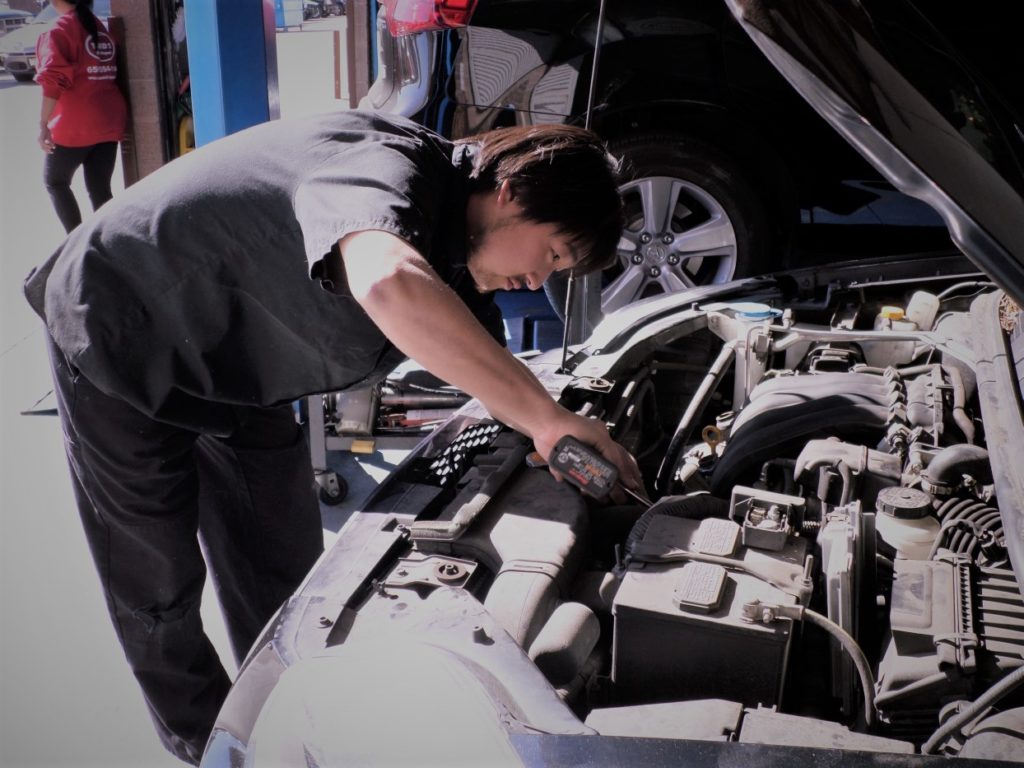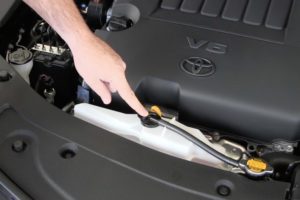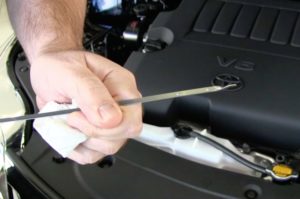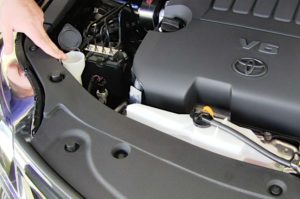
Every vehicle owner should have a basic understanding of the many vital fluids found under the hood. Photo: T & S Auto Repair ©2020
Are you familiar with the many fluids found under the hood of your car? If not, the following article is for you.
Fluids are the lifeblood of your vehicle. Some serve to cool and lubricate the engine and transmission, while others help facilitate the operation of the steering and braking systems. All of them are important and should be regularly inspected. Let’s look at each of these fluids in more detail:
1. Coolant (antifreeze)
A mixture of distilled water and ethylene glycol, coolant is designed to maintain the temperature of the engine and radiator. Engines generate a lot of heat as they run, so coolant absorbs that heat and prevents overheating. Conversely, coolant also keeps the water in the radiator from freezing in extreme cold (thus the term “antifreeze”).

When adding coolant, always do so at the reservoir fill point, not the radiator cap. Photo: American Ratings Corporation ©2020
Coolant is housed in a semi-transparent reservoir that’s adjacent to the engine; the “full” and “low” line indicators make it easy to see the fluid’s level. If the fluid is below the “full” line, simply add more. Take note: Coolant should always be refilled at the reservoir fill point, not the radiator cap. Additionally, do not attempt to add coolant when the engine is hot—because the system is pressurized, removing the reservoir cap while the engine is hot can result in injury. If your vehicle’s coolant level is consistently low, have an automotive professional assess the situation.
2. Brake fluid
Brake fluid’s primary function is to aid the movement of the brake pedal, but it also lubricates and prevents corrosion of the braking system’s various components. Like coolant, brake fluid is housed in a semi-transparent reservoir that’s adjacent to the engine, with line indicators to denote its level.
Adding brake fluid is not typically part of routine vehicle maintenance (there’s no set interval for replacement), so it’s good to keep an eye on the level in the reservoir. Fortunately, even if you forget to do this, the ABS (anti-lock braking system) dashboard light will usually illuminate if the fluid gets too low. If you notice a sudden drop in fluid level, it could indicate a problem with your braking system (such as a leak), or it might just be time to replace your brakes.
Before adding brake fluid to your car, make sure you’re using the right type. There are four types available: DOT 3, DOT 4, DOT 5 and DOT 5.1 (DOT stands for Department of Transportation, which sets the quality standards for brake fluid). Using the wrong brake fluid can cause problems, so consult your owner’s manual to find out which one is right for your vehicle.
3. Engine oil
Engine oil serves a number of important functions. It lubricates the engine’s moving parts, reduces heat buildup, keeps the engine clean and prevents corrosion. Not surprisingly, when engine oil gets too low, it can have significant consequences. That’s why if the oil light illuminates on your dashboard, you should stop your car immediately and call for a tow to a repair shop.

Both engine oil and transmission fluid can be checked using a retractable dipstick. Photo: American Ratings Corporation ©2020
To avoid this scenario, regularly check the level of your car’s oil (at least every 500 miles). While your engine should be turned off before you check the oil, it’s best if it’s warm, as this will provide a more accurate reading. Locate the retractable dipstick; typically, it’ll be the one with the yellow handle (as opposed to the red-handled transmission fluid dipstick). When you pull out the dipstick, you’ll see two notches: one that denotes “full” and one that denotes “low.” If the level is at or below the “low” notch, add some more. Consult your owner’s manual for the correct type of oil and where to add it.
Engine oil should be changed at regular intervals. The specific interval can vary substantially depending on whether your vehicle uses regular or synthetic oil, so consult your owner’s manual. Whether you choose to replace your oil yourself or have a professional handle it for you, oil changes are crucial for the health of your car’s engine.
4. Power steering fluid
Power steering fluid is a hydraulic fluid that makes power steering possible on modern vehicles. As with brake fluid, there’s no set time frame for power steering fluid to be replaced. If you notice that you’re having greater difficulty turning your steering wheel or you hear squeaking sounds when you turn, it’s time to check the fluid level.
Like coolant and brake fluid, power steering fluid is housed in a semi-transparent reservoir with a line indicator to denote its level. If the fluid level is low, add some more. As always, check your owner’s manual to make sure you’re using the correct type of power steering fluid for your vehicle. If the fluid level is consistently too low, you may have a leak, in which case you should have it looked at by a professional.
5. Transmission fluid
Transmission fluid acts as a lubricant for the moving parts inside the transmission. In automatic transmissions, the fluid also acts as a coolant and helps transfer power from the engine to the transmission.
To check your transmission fluid, locate the dipstick (usually red-handled) and repeat the same process as you would for checking your oil, making sure the fluid level is within the acceptable range. You should also inspect the integrity of the fluid—it should appear bright red and have a somewhat sweet scent. If the fluid appears dirty or smells burnt, it’s likely due for a change.
As with engine oil, transmission fluid should be professionally serviced at regular intervals. Ideally, you should get a complete fluid and filter change every 40,000 miles. This simple step will add years to your transmission’s life and prevent costly damage.
6. Windshield washer fluid
While it has no impact on vehicle performance, windshield washer fluid helps ensure driving safety by allowing you to clean your windshield in a visibility emergency. Like most fluids found under the hood, it’s housed in a semi-transparent reservoir that makes it easy to assess the fluid’s level.

Windshield washer fluid helps ensure driving safety by allowing you to clean your windshield in a visibility emergency. Photo: American Ratings Corporation ©2020
Windshield washer fluid contains ingredients like methanol and ethylene glycol, which provide effective cleaning power and prevent freezing during extreme cold. You can also make your own washer fluid by combining 1/2 cup of ammonia, 1 tablespoon of dish soap and 1 gallon of water. Just keep in mind that this homemade version won’t protect against freezing like standard washer fluid.
Need a fluid service for your car or more information about a specific type of fluid? Contact a Diamond Certified auto repair shop or transmission specialist in your area.
